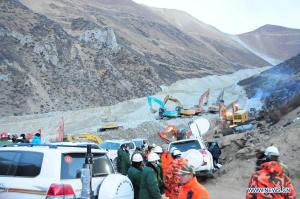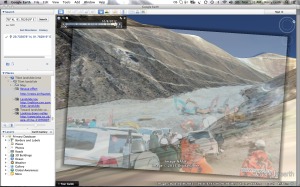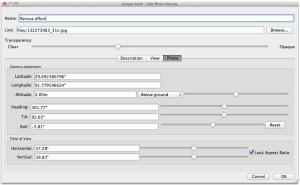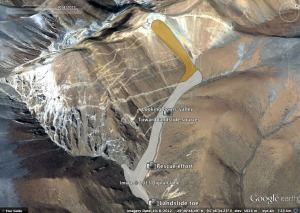Just under three weeks ago a catastrophic landslide claimed the lives of 83 workers at a copper/gold mine in China’s Tibet Autonomous Region. The victims are reported to have been local workers employed by a Chinese national mining company. Many details of this tragic event are described in news reports, and summarized on Dave Petley’s landslide blog, where a recent post sparked my interest. Dave makes reference to official reports that attribute the cause of the event to fracturing of natural gravel on the slope, but notes on his blog that recent Google Earth images from May and August last year show clear evidence of mountain top mining and end-tipping of waste onto a slope in the region. Dave suggests that the unusually long runout of the event may have been aided by the fractured nature of the gravels in the initiation zone, and suggests this mining activity may have had something to do with it.
A press photo of the rescue crews working at the site of this very large, highly mobile landslide.
Although there is understandably a large amount of press coverage regarding the event, there has been very little information on the landslide itself, and most reports focus on the sometimes thousands of rescuers who have been working at the site. Images in the media do, however, show large parts of the landslide, and offer a good opportunity to illustrate how tools such as Google Earth can be used to map 3D structures from such 2D photographs. While there are a number of commercial and non-commercial software packages that currently allow users to generate 3D point clouds from multiple photographs, there are few that allow details from photographs to be projected onto digital elevation models. Some architectural software such as Sketchup allow the mapping of photographic textures onto simple geometries, but as far as I know there is nothing currently available for geotechnical applications.
The above press photo overlaid on a Google Earth terrain model using the Add>Photo dialogue.
The Add>Photo dialogue in Google Earth is one tool which provides a simple means of combining on-site photographs with spatial geodata. This first requires that a user can reasonably accurately locate the point from which a photograph was taken. In this case, the task was not too difficult, as the existing mining roads provided me with features to “walk along” using the ‘Ground level’ option in GE. I could then use features in the photos to locate the most likely observer positions.
Options in the dialogue allow full control over image positioning and transparency.
Next, using the ‘Photo’ tab of the ‘Add Photo’ dialogue, I changed the heading, tilt, roll, and field of view, to match features in a semi-transparent photo with those on the Google Earth model. By zooming out of the photo a little I could then approximately map the landslide extents ‘through’ the photos using the Add>Polygon tool. This step required some trial and error, as for some reason it only allowed me to move nodes in the lower left corner of the screen, however, in an hour I was able to map the region of the landslide (indicated in grey in the lower figure). Although the photographic coverage of the valley is incomplete, I could also infer a potential source region (in orange), and derive the pre-mining valley long-profile indicated in the figures below (see my previous post for info on this tool). A .kmz file containing the data for Google Earth is available for download at the bottom of this entry (I take no responsibility for it’s accuracy), to view photos from the photographer positions simply click on the camera icons once the file is loaded in the Google Earth browser.
A map of the visible landslide deposit (grey) and source area (orange) inferred from the
run-up of landslide debris in the valley. Note the steep grey and white slope related
to recent mining activity at the inferred source location. Cameras and text
indicate the location of images used to ‘map’ the landslide.
run-up of landslide debris in the valley. Note the steep grey and white slope related
to recent mining activity at the inferred source location. Cameras and text
indicate the location of images used to ‘map’ the landslide.
A long-profile of the landslide source and runout zones. Note the slope gradient prior
to the dumping of spoil was ~50% (22.5 deg). This is already approaching that of
many natural talus slopes containing loose gravel (typically <35 deg) and clearly
does not leave much room for storage of non-engineered mining waste on the slope.
to the dumping of spoil was ~50% (22.5 deg). This is already approaching that of
many natural talus slopes containing loose gravel (typically <35 deg) and clearly
does not leave much room for storage of non-engineered mining waste on the slope.
This analysis provides some interesting insights into the event. The BBC video image looking toward the landslide source appears to show that debris ran from left to right across the valley floor, and partially into the right-hand side catchment before flowing down-valley. This suggests the source was in fact from the upper left, and may correspond to the location of what appear to be end-tipped gravels in recent mid- and late-2012) satellite images. In addition, these images show that at least late last year, there was no settlement capable of supporting 80 workers within the landslide runout zone. The majority of structures are located on the ridge crest, and close to the excavation site. While it is possible that a new camp was erected after the satellite images were taken (there seems to be some ongoing road construction), it would be very disturbing to discover that any, let alone so many, workers were operating on such a steep end-tipped gravel slope adjacent to the mining site.






Recent Comments